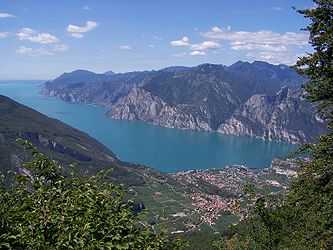Battle of Lake Benacus
| Battle of Lake Benacus | |||||||
|---|---|---|---|---|---|---|---|
| Part of the Roman-Alamanni conflict | |||||||
 Lake Garda, the location of the battle | |||||||
| |||||||
| Belligerents | |||||||
|
| Alamanni | ||||||
| Commanders and leaders | |||||||
|
Claudius II Aurelian | Unknown | ||||||
The Battle of Lake Benacus was fought along the banks of Lake Garda in northern Italy, which was known to the Romans as Benacus, in 268[2] or early 269 AD,[1] between the army under the command of the Roman Emperor Claudius II and the Germanic tribes of the Alamanni and Juthungi.[1]
Background
Ιn 268, the Alamanni, who had been making incursions into Roman territory since the reign of Marcus Aurelius, had broken through the Roman frontier at the Danube and crossed the Alps. The power struggles in Mediolanum due to Aureolus' revolt, the murder of Emperor Gallienus and the resulting confrontation between Aureolus and Claudius, who had been nominated as emperor by Gallienus on his death bed, forced the Romans to denude the frontier of troops.[1] Having defeated and killed Aureolus in the Siege of Mediolanum Claudius led his army, together with the remants of Aureolus' force, north to confront the Germans.[1][3][4]
Battle and aftermath
Details of the battle are unknown but future emperor Aurelian certainly played a part.[1] After what was described as a complete victory, Claudius assumed the title Germanicus Maximus.[1][3] Much of the German army was slaughtered on the field with the remainder retreating beyond the bounds of the empire.[4] Claudius returned to Rome after the battle to attend to affairs of state.[3] The Alemanni returned to Italy in 271 and won a victory against Emperor Aurelian at the Battle of Placentia[2] before their ultimate defeat in the Battle of Fano.
References
- ↑ 1.0 1.1 1.2 1.3 1.4 1.5 1.6 Watson, Alaric (1999). Aurelian and the Third Century, Routledge, 1999, ISBN 0-415-30187-4. p. 43
- ↑ 2.0 2.1 Jacques, Tony (2007). Dictionary of Battles and Sieges: F-O. Greenwood. p. 562.
- ↑ 3.0 3.1 3.2 A'Beckett, William (1836). A Universal Biography. Isaac, Tuckey, and Company. p. 825.
- ↑ 4.0 4.1 Bathurst, C. (1780). An Universal History: From the Earliest Accounts to the Present Time, Part 1, Volume 14. p. 20.
Coordinates: 45°34′50″N 10°37′14″E / 45.58060°N 10.62053°E